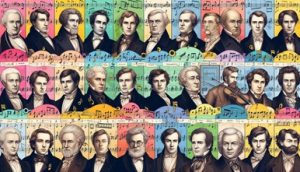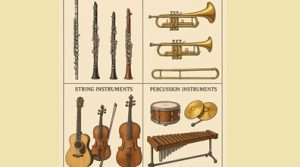Composer Timeline: List of Classical Music Composers
Composer Timeline: List of Classical Music Composers
Touring the composer timeline with me
Welcome to our exploration of Western classical music history! This list stretches across centuries and offers various styles, but it is not exhaustive.

There are too many greats to fit here! For those embarking upon their exploration, this is a place where one can begin.
Want to get deeper into the life of any given composer and what their works are all about? Just click on their name for an appropriate link to their Wikipedia page.
Composer Timeline Chronology: Music History through the Ages
As one reads onward, it is quite noticeable that some of these composers may be found in more than one era. That is because musical styles seldom change overnight.
Several have been significant in tying two different periods together, such as Beethoven (yes, we are talking of you). If in doubt about the era of a composer, refer to the period alongside the dates.
Composer Timeline Chronology:
Medieval Period
Topocentric: music had existed in Europe for centuries, and the medieval period marked a decisive moment in its history: notation made it possible to write down music so that it could be shared all over, rather than being passed on mainly by ear.
Simple chant-like melodies in the early medieval period were also mostly of a religious nature and rhythmless. Over time, frank harmony came into existence, though typically as the same melody sung at different pitches.
Let’s just say it was far from what composers like Bach would do.
Important Medieval Composers:
- 1098–1179 – Medieval
- 1291–1361 – Medieval
- 1300–1377 – Medieval
- 1325–1397 – Medieval
Composer Timeline Chronology:
Renaissance era
In many ways, the Renaissance, meaning “rebirth,” acted as a strong cultural movement across the countries of Europe, and has often been viewed as the beginning of what we now call the modern world.
The Middle Ages were a period considered by many as a time of intellectual dormancy under the influence of the church and the wealthy elite; the revival brought about changes in art, science, architecture, literature, of course-music.
One of the great luminaries of this age was Leonardo da Vinci, whose reputation extended to nearly every field he touched.
Music was the only art where vast improvements were brought forth during the Renaissance.
Having started on the improvement of their art, composers began to put music into a real art form. The notation systems improved. This was, together with the invention of the printing press, a great contribution toward making music available to a wider audience.
Although religious music still had the upper hand in the early years, composers gradually spread their wings into the market of secular music and composed pieces that are called madrigals-nature, love, and life, lively songs that celebrate the joy one feels for them.
Some renowned Renaissance Composers:
- 15051585 Renaissancee
- 1525-1594 Renaissance
- 1539-1623-Renaissance
- 1567-1643-Renaissance/Baroque
Composer Timeline Chronology:
Monument in Baroque
On the ground that the Renaissance laid, the Baroque brought about a transformation with new grandeur in music, art, architecture, and literature.
The Baroque period was the first to introduce the “Common Practice”-that is, the time when many of the rules and musical traditions that can still be recognized today were established.
Much as the architecture of the time was richly ornamented, Baroque music was also richly ornamented.
Composers would establish what the bass line should be, add to it with numbers (called figured bass), and leave the musicians to construct the harmonies themselves—a form of improvisation rather close to jazz, albeit on a harpsichord rather than a saxophone.
Prominent Baroque Composers:
- 1678–1741 Baroque
- 1681–1767 Baroque
- 1685–1759 Baroque
- 1685–1750 Baroque
From that of the Baroque, which produced rather florid and often improvisational music, the Classical period introduced a more clean-cut and structured mode of expression, much lighter in spirit.

This period developed during the Age of Enlightenment period in which scientific discovery blossomed and the traditional religious beliefs came under open challenge.
Music, as well as architecture, embraced brightness, clarity, balance, and symmetry, inspired yet again from ancient Greece and Rome.
The guidelines that should define a musical work were strictly stipulated to include expectations regarding form, modulations, and the allocation of instruments during the Classical period.
The orchestras later became more standardized concerning their sizes and configurations, as new instrumental forms such as the symphony or string quartet held sway over the listening audiences.
Most notably, it was during this time; some great masters, such as Mozart, together with Haydn, were productive and made extensive contributions to these genres-Haydn alone wrote over 100 symphonies.
But it was also within the Classical period that the piano made its first foray into music performance and the revolution of musical performance as a whole.
Key figures:
- 1735 to 1782 (Classical)
- 1756 to 1791 (Classical)
- 1770 to 1827 (Classical / Romantic Transition)
- 1797 to 1828 (Classical / Romantic Transition)
Composer Timeline Chronology:
Romantic Period
Artists and writers had dark and highly dramatic themes and would frequently set their works in wild, remote locations.
Happy endings became infrequent and marked a counterpoint to many of the Classical operas’ playful spirits.
Musically, composers started departing from Classical creeds; expression of emotion outweighed the importance of formal design.
Harmonically, composers were getting ever bolder and bolder. Orchestras were growing, expanding in size to project louder and richer sounds.
Key Individuals:
- 1797-1828,(Classical/Romantic transition);
- 1803-1869,(Romantic);
- 1804-1857,(Romantic);
- 1805-1847,(Romantic).
Composer Timeline Chronology:
Modern Era
At this point in our timeline, the word “modern” might feel a little misleading–after all, it refers to music that began over a hundred years ago!
The Modern Era encapsulates the spirit of composers from the early twentieth century who dared to offend and rethink the traditional rules of music, which had been, by and large, stable since the Renaissance.
Unlike all that had come before, the Modern era exploded into a patchwork of wildly different styles.
Where the Romantic composers stretched and bent the rules, Modernist composers very often put the rulebook through the shredder.
Movements such as Serialism were based on strict mathematical structures, dismissive of any traditional considerations of harmony; the results, sounding as they do today, may still seem uncomfortably daring and foreign.
Many a composer bade farewell to heroic Modernism.
Some turn to Classical inspiration for the style Neoclassicism; others pushed ever further into the lush emotional worlds created by the Romanticists.
Notable Modernists:
- 1860-1911–Romantic/Modern
- 1862-1918–Modern/ Impressionist
- 1864-1949–Romantic/Modern
- 1865-1935—Modern
Present Time
The modern-day (and beyond) will welcome you.
As modern times had almost taken music to the extreme heights of creativity, a natural question arose: what could happen next? The answer is everything and anything.
The two important strands: The first is Minimalism, which was born in the middle of the 20th century.
It took music down to its bare four walls, using uncomplicated and repetitive patterns to induce states of senselessness within the nearly entranced listeners.
You wouldn’t believe it, but this style paved the way for the growth of styles like Techno and other dance music.
On the other hand, composers started to explore this new frontier of electronics, introducing synthesized sounds, recorded noises, and experimental instruments.
Avant-garde composer John Cage created pieces that featured complete silence and modified pianos by inserting objects between their strings to produce whole new sonic textures. At present, contemporary music knows no boundaries.
With a grand history behind and unlimited arms of tools available for usage, the composer might find himself drawing inspiration from classical traditions, advanced technologies, world music styles, and anything in between. The possibilities are truly endless.
Notable Contemporary Composers:
- 1918-1990-Contemporary
- 1923-2006-Contemporary
- 1925-2016-Contemporary
- 1928-2007-Contemporary





